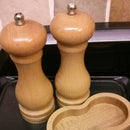Introduction: Acrylic Jenga Pistol
The original design is by Matthias Wandle which he wrote about on his woodworking site, woodgears.ca. The design uses a captive bolt, powered by an elastic band to blast the Jenga block out of its space before it knows what's hit it! I visit his site weekly so had read about his attempts at selling some of his Jenga pistols, which didn't go as well as he'd hoped because the interest had died down and they took too long to make in wood.
His efforts inspired me to make an acrylic one which I could laser cut, not to sell, but because I have a laser cutter and it was faster for me to do it this way than with wood, plus I've always wanted one after I saw his.
This Instructable shows how I designed my version and how it works, as well as some of the other fun I've had with it.
Step 1: Design
The pistol was laser cut from 5mm acrylic. Laser cutting it gives a beautifully polished edge so once cut, no finishing's required, just bolt it together.
Before laser cutting my prototype I drew it in the CAD package I use, Alibre Design. This let me throw together a full assembly to check all of the pieces would fit, then export them as a DXF for the laser cutter.
My design was based loosely on the one by Matthias Wandle, I changed the way I attached the rubber bands to suit laser cutting better and changed the stock. Since it didn't add any machine time I later added some flourishes to make it look fancier, like a pretend sight and some grips on the front of the stock.
Step 2: Prototype 1
My first mockup's design was thrown together in an hour, it took 15 minutes to laser cut.
Despite being rough around the edges since I'd just used machine screws straight through with some ugly nuts on the other side it was fine for checking it worked.
Fresh off the laser cutter I threw the bits in a bag with some nuts 'n' bolts and dashed off to my boss' house for dinner where I put it together with one of his sons, Jonny, and proceeded to test it with beer bottle caps and bits of onion, much to Steve's amusement then mild annoyance.
Step 3: Improvements
The first design was a lot of fun and I CADed it in a hurry in just over an hour. As such it had a few flaws I wanted to improve upon. The next version I wanted to fix these problems:
1) The hole the band for the trigger goes through was a bit small, a slot would be easier to pass an elastic band through.
2) The trigger band hole was too close to the trigger so it caught on it.
3) The trigger needed something to stop it inverting after the bolt had been flung forwards.
4) The bolt wasn't long enough, so it only protruded 5mm past the end of the gun.
5) The gun looked a bit plain, I fancied adding a fake sight and some finger impressions on the grip.
6) The bolt layer needed to be thinner so it didn't foul on the end, to fix this I wanted to make the gun out of 6mm acrylic and the bolt from 5mm.
7) Replace the machine screws and nuts with machine screws and domed nuts to give it a more finished look.
8) In the prototype the middle layer was three pieces, a small inner stock, the top bracket and the bottom bracket. This made it difficult to put together because you couldn't keep them square without tightening the bolts lots. In the next one this middle layer will be one piece, making it easier to put together and faster to laser cut since the path will be smaller.
Step 4: Final Design
One final adjustment to the design that I made was to remove the prongs on the slider that held the elastic band. I removed these and added a cut-out in the middle layer of the slider so that the band could hook around the screw. This meant there was no chance that the bands could come off when firing.
Once I'd tweaked the bits I wanted to, the final design was laser cut from 5mm acrylic.
The files in this step are provided for personal use on the condition that they or parts cut with them aren't sold.
The pistol's bolted together with M3 machine screws and nuts. The end plates and slider are spaced with washers so that the plunger doesn't get caught on the end plates, since it's the same width as them.
Attachments
Step 5: Usage
Pull back the trigger and fire!
The bolt moves so fast that you can shoot out blocks that aren't normally removable by hand. But be careful, when especially wobbly it make knock the tower over when a gentle poke would be better.
Other uses:
- turning off light switches
- firing bits of food
- attach a magnet to hold and then fire bottle caps

Participated in the
4th Epilog Challenge














